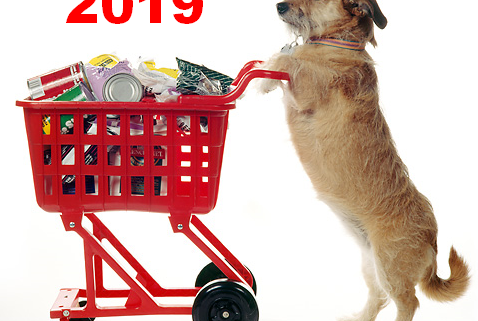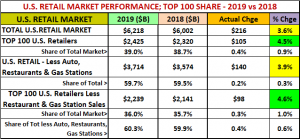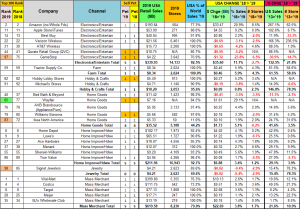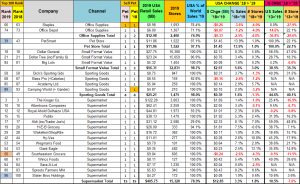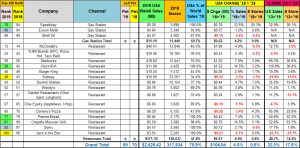2019 Top 100 U.S. Retailers – Sales: $2.4 Trillion, Up 4.5%
The U.S. Retail market reached $6.22 Trillion in 2019 from all channels – Auto Dealers, Supermarkets, Restaurants, Online retailers and even Pet Stores. This year’s increase of $216B (+3.6%) was 23.4% below last year’s increase of $282B. This breaks a string of steadily growing increases which began in 2015. One factor is that fuel prices stabilized, and Gas station revenue flattened out. (Data courtesy of the Census Bureau’s monthly retail trade report.)
In this report we will focus on the top 100 Retailers in the U.S. Market. These companies are the retail elite and account for 39% of the total market. The vast majority also stock and sell a lot of Pet Products. The retail market is constantly evolving which produces some turmoil – mergers, acquisitions, closures. The Top 100 are not immune and you will see changes in ranking but for first time since I began tracking in 2013, the list is the same as last year. The report does contain a lot of data, but we’ll break it up into smaller pieces to make it more digestible. All of the base data on the Top 100 comes from Kantar Research and was published by the National Retail Federation (NRF).
We’ll begin with an overview:
- The total Retail Market grew $216B in 2019 (+3.6%). In 2018 it was +4.9% and in 2017, +4.3%. Although sales are still increasing, the growth rate slowed markedly in 2019.
- The Top 100 grew $105B (+4.5%). This is less than last year’s +4.8% but significantly better than the total market.
- The Top 100 generates $2.4 Trillion in revenue, 39.0% of the total U.S. retail market – slightly more than 2018.
- Let’s make the data a bit more relevant. If you remove the revenue from Auto, Restaurant and Gas Stations, the “targeted” retail market for the Pet Industry is $3.7 Trillion – 59.7% of the total market. By the way, the slight gain in share is due to the flattening of Gas Station revenue.
- If we also remove Restaurant & Gas Station $ from the Top 100, the remaining $2.2T is 36.0% of the total market.
- … and 60.3% of the $3.7 Trillion “target” market.
The Top 100 generally outperforms the overall market. In 2019 the difference in performance was significant. The lift was driven by the Top 100 targeted retail group, less restaurants and gas stations. Remember, the Top 100 is really a contest. In a “normal” year companies drop out and new ones are added. This can be the result of mergers, acquisitions or simply surging or slumping sales. In 2019 there were no changes. However, here are some significant changes in rank:
- You see the growing strength of the internet.
- Wayfair moved up 12 spots from #77 to #65
- Sales for these 2 companies continued their downhill slide.
- Sears from #60 to #75
- GameStop from #75 to #97
Now let’s start “drilling down” into the specifics of the 2019 Top 100. Here’s a summary of Regular and Online Retailers versus the bundled total for Restaurants & Gas Stations.
- Regular & Online Retailers have 58.4% of the stores but 92.3% of the business, up slightly from 92.1% last year.
- 93.0% of the increase came from Regular/online retailers. However, they are only up 4.6% versus +5.2% in 2018.
- Restaurant sales were up $6.7B (+4.0%) in 2019 and Gas Stations turned positive, +0.62B (+4.2%).
- The overall Store count was up +0.6% versus +0.8% in 2018. The lift was driven by Gas Stations (+9.0% due to an acquisition) and Restaurants (+0.8%). Regular retailers were basically flat (+0.03%).
Now that we have an overview of the Top 100, let’s take a look at the “targeted” retailer segment. There are 82 total companies. How many are buying and selling Pet Products? This will reinforce how Pets have become an integral part of the American Household and how fierce that the competition for the Pet Parents’ $ has become.
- Of 82 companies, 69 are selling some mixture of Pet Products in stores and/or online. (down from 70 in 2018)
- Their Total Retail Sales of all products is $2.09 Trillion which is…
- 93.4% of the total business for Regular & Online Retailers in the Top 100
- 33.6% of the Entire $6.22T U.S. Retail market – from 69 Companies who sell Pet Products.
- Their Total Retail Sales of all products is $2.09 Trillion which is…
- 58 Cos. (up from 56), with $1.99T sales sell pet products off the retail shelf in 145,607 stores – 2600 more than 2018.
- As you can see by the growth in both sales and store count, in store is still the best way to sell pet.
- Online only is another story and the story gets complicated.
- Amazon includes Whole Foods, which has stores so the Amazon $ are in the “Pet in Store” numbers.
- 2 traditional Retailers who only sold Pet Products online converted to in store. The others who only sell pet online are losing market share. However, internet only retailers, like Wayfair are showing strong growth
Pet products are an integral part of the strongest retailers and are widespread across the entire U.S. marketplace. Of the Top 100, 145,600 stores carry at least some pet items at retail. There are thousands of additional “pet” outlets including 20,000 Grocery Stores, 10,000 Pet Stores, 16,000 Vet Clinics, 5,000 Pet Services businesses and more. Pet Products are on the shelf in over 200,000 U.S. brick ‘n mortar stores… plus the internet.
Before we analyze the whole list in greater detail let’s take a quick look at the Top 10 retailers in the U.S.
- They did $1.33 Trillion in Sales
- 54.8% of Top 100 $ales
- 21.4% of Total U.S. Retail $
- No change in rank (The group is unchanged since 2015)
- Sales are up for all. Amazon leads the way…again.
- Store count is down 500, (-1.4%)
In the next section we will look at the detailed list of the top 100. We’ll sort it by retail channel with subtotals in key columns. We’ll then break it into smaller sections for comments.
I have not done a lot of highlighting however:
- Pet Columns ’19 & ‘18 – a “1” with an orange highlight indicates that products are only sold online
- Rank Columns – Change in rank from 2018: (Note: Acquisitions, Divestitures and Corporate Restructuring can cause big changes in ranking.)
- Up 4-5 spots = Lt Blue; Up 6 or more = Green
- Down 4-5 Spots = Yellow; Down 6 or more = Pink
Let’s get started. Remember online sales are included in the sales of all companies
Observations
- After a number of acquisitions over several years, Drug is still in turmoil. Now we are seeing a growing number of closures of unproductive stores. However, sales growth remains strong.
- The Traditional Department store segment continues its overall decline. Nordstrom stores were an exception with small gains in both sales and number of outlets for 2 straight years. Belk, a small chain, had the biggest $ales growth.
- Sears sales and store count continue to plummet.
- Saks sold Lord & Taylor in November 2019.
- Although all carry a few pet items, often online, this channel has never fully embraced Pet Products.
- Much of the growth in the Convenience Store Chains in the Top 100 in recent years has come through acquisitions. In 2019 there were no major acquisitions, but both major chains had small increases in $ales and stores.
- Military Exchanges/Commissaries have added locations in recent years, which fueled the growth in sales. In 2017 they began reducing the number of Army/AF Exchanges. By 2019 this policy had spread to all military groups. 2019 sales were up in the Army/AF group which kept the overall drop in Military Exchg/Commissaries to -$0.06B (-0.5%).
- Auto Parts Stores have become more stable in their growth. All chains increased their store count for the 2nd consecutive year. Overall, sales were up 5.5% in 2019 versus +2.5% in 2018.
- Among Apparel retailers, the value outlets continue to show strong growth. All three of these chains carry pet products. The Gap sold Old Navy and no longer offers pet products. Ascena closed all Dress Barn stores (650).
Observations
- Amazon continues to drive the evolution of U.S. Retail. Sales are up 267% in 5 years. With the acquisition of Whole Foods in 2017 they also have a small but growing brick ‘n mortar presence in the market.
- Of the three Phone People, only Apple had a strong year.
- QVC lost ground in 2019. Sales were down -5.2% and they fell 3 spots to #44 in the ranking.
- In 2017 a move to online gaming began. GameStop sales continue to fall, and closures grow. They fell 22 spots.
- Signet Jewelry’s sales were down -0.04%. This was bad but better than -3.4% in 2018 and -3.9% in 2017.
- Mass Merchants have 2 of the 4 largest volume retailers in America – Wal-Mart and Costco. Recently, these two companies have driven the growth in this channel. In 2019 Costco was strongest, but all companies increased sales.
- Wal-Mart had a 2.6% increase in sales which is below last year’s 3.4%. Their business is mixed as SuperCenters continue to grow and their online sales are taking off. However, “regular” Discount Department Stores are losing market share. These trends impact the overall business in both Wal-Mart and Target.
- Target posted a third consecutive sales increase in 2019, after 3 years of flat or declining revenue.
- Costco continues its strong growth (+9.3%), building new stores and increasing sales – both in store and online.
- BJ’s sales were up for the second consecutive year after a string of annual declines from 2013 to 2017.
- Meijer had small growth in sales and store count in 2019. However, since 2013 they rank third overall in the percentage of sales increase and first in the percentage of store count increase.
- All Home Improvement/Hardware companies increased sales, but overall, the growth slowed a bit, from +4.3% to +3.4%. Store count turned positive but Lowe’s and True Value continued closures. Home Depot (#6) and Lowes (#9) led the way in sales growth, supplying $5.24B (76%) of the $6.88B lift in the category.
- Like 2018 all Home Goods Companies but Bed Bath & Beyond increased sales. They also drove down store count. Sales were up 5.1%, again driven by Wayfair, who entered the top 100 in 2018 and now ranks #65, up 12 from last year.
- Tractor Supply was up 5.9% which is much less than 2018, +11.4%, and below their average growth rate of +8.3% since 2013.
Observations
- Supermarkets – $406B in Sales; 15 Companies; 15,000 stores; All Selling Pet Products. This is a very important group for the Pet Industry. With the highest frequency of consumer visits of any channel, the competition is fierce. The mergers and acquisitions have slowed. All companies but Southeastern showed increased sales. However, the strongest growth came from Sprouts (Natural) and Aldi (Value).
- Southeastern Grocers filed for bankruptcy in 2018. Store closures and reduced sales continue.
- Small Format Value Stores: Remember, this retail channel does more business than Traditional Department Stores.
- As expected, Dollar General increased its lead over Dollar Tree in Sales, Sales Increase and Store Count.
- Dollar Tree continues to increase sales, but its store count growth rate has slowed.
- Big Lots had small growth in sales and stores after trending down in both areas in 2018.
- This retail channel continues to grow in popularity. They are committed to Pet Products and their focus on value appeals to today’s ever more price conscious consumers. Plus, they are easy to shop.
- Pet Stores – After the acquisition of Chewy in 2017, PetSmart’s sales registered a huge increase. In 2018, their sales were up +4.7%. In 2019, driven by the increasing popularity of the internet and Chewy, sales grew an impressive +14%. Petco qualified for the Top 100 for the first time in 2016. This was widely viewed as evidence of the strength of the U.S. Pet Industry. They hung on in 2017 but dropped out in 2018. It looks like they need a new formula, perhaps the internet, to make it back into the club.
- Office Supply Stores – This channel continues its decline as Consumers are increasingly moving to online ordering.
- Sporting Goods – Bass Pro (includes Cabela’s) continues to struggle but the other 3 companies eked out a small sales increase (2>3%) in 2019. Sales are up overall for the category but all companies, but Academy Sports are closing some underperforming stores.
Restaurants & Gas Stations and the Grand Total
Restaurant & Gas Station Observations
Although restaurants & gas stations aren’t relevant in terms of Pet Products Sales, they are relevant in our daily lives.
- In 2019 although 4 companies had decreases, the overall sales for Restaurants in the Top 100 was up 4.0%%. This was better than the 3.6% increase in 2018 but less than the 4.6% increase in the total restaurant channel. McDonalds led the way in $, +$1.89B, but Chick-fil-A and Chipotle tied for the biggest percentage increase, +14.5%.
- Falling gas prices in 2019 flattened the revenue growth of the total Gas Station Channel. The Top 100 Gas Station sales and stores are both up solely because Speedway acquired Andeavor Brands with their 3200+ outlets.
Wrapping it up!
The Top 100 became the Top 100 by producing big sales numbers and their performance, except for 2018, usually exceeds the overall market. In 2019 things returned to “normal”, +4.5% for the Top 100 vs +3.6% for Total Retail. The Top 100 Gas Stations, with a major acquisition, far exceeded the full market performance. However, top 100 restaurants underperformed to the overall Restaurant channel. If you just compare the “regular” retailers – both brick ‘n mortar and internet, then the Top 100 “won” big, +4.9% to +3.6% for the total “relevant” retail market.
Pet Products are an important part of the success of the Top 100. Sixty-nine companies on the list sell Pet Food and/or Supplies in 145,600 stores and/or online. Let’s take a closer look at the fifty-eight companies that stock pet products in their stores. This group generated $1.99T in total sales. How much was from pet? Let’s “Do the math”. If we take out the $11.9B done by PetSmart and the remaining companies generated only 1.5% of their sales from Pet, we’re looking at $29.7B in Pet Products sales from only 57 “non-pet” sources! (Note: The 1.5% share for Pet items is a low end estimate based on data from the U.S. Economic Census.) After a major adjustment, the APPA reported $56B in Pet Products sales for 2019. That means that 57 mass market retailers accounted for 53+% of all the Pet Products sold in the U.S. in 2019.
Pet Products are widespread in the retail marketplace but the $ are concentrated. Regardless of your position in the Pet Industry, monitoring the Top 100 group is important. This group also reflects the ongoing evolution in the retail market – the growing influence of the internet and the importance of Value. The group was relatively stable in 2019, with no changes from 2018. Competition is still intense, and the current COVID-19 crisis will likely cause turmoil in 2020.

